 Forever Yong’s garlic harvest is ready to go to market.
Forever Yong’s garlic harvest is ready to go to market.Production of Feeding Our Future is made possible with the support of the Zuckerman Family Foundation.
It’s a Thursday afternoon and people who are just getting off work stop by the Mercado San Agustin to pick up bags of fresh salad greens, bundles of Swiss chard and just-picked pomegranates from Mission Garden. This farmers’ market is one of three run by the Community Food Bank of Southern Arizona.
“Part of what the food bank does is the traditional things that you would expect: getting food from somewhere, whether it’s a grocery store or commodities, and getting it out to people that need it,” says Kara Jones. She is the Community Food Bank’s Farmers’ Markets Manager. “Years and years of doing that, honestly, isn’t solving the problem of people needing food. We can’t feed people out of hunger; we can’t feed them out of poverty.”
Jones says the Food Bank wondered: “What if we took some resources and put them into making people be able to take care of their own food needs?”
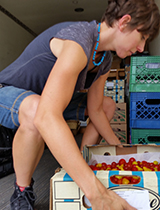 Kara Jones is the Farmers’ Market Manager for the Community Food Bank of Southern Arizona.
Kara Jones is the Farmers’ Market Manager for the Community Food Bank of Southern Arizona. 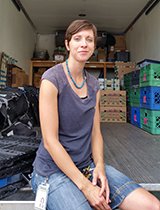 Kara Jones
Kara Jones But, how? Jones points to a long table under one of the archways. It’s loaded with a wide variety of fruits and vegetables, including micro-greens, carrots, summer squash, figs, green onions and tomatoes. This food was grown by Food Bank clients. They’re part of a Food Bank program called the Abundant Harvest Cooperative, which is a collective of more than 150 backyard gardeners and a new small farmers.
The backyard growers came to the Food Bank for hunger assistance and then they were invited to take a gardening class. Now they’re growing food at home. but some weeks they have surplus food. The Food Bank sells it for them, on consignment, at its farmers’ markets. Jones says the Cooperative earns $100,000 a year.
“When people have income they’re not in poverty and don’t have to stand in line at the food bank.” – Kara Jones, Community Food Bank of Southern Arizona
 The Abundant Harvest Cooperative is made up of 150 small farmers.
The Abundant Harvest Cooperative is made up of 150 small farmers. 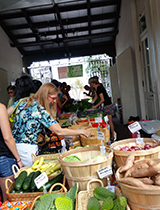 Mercado San Agustin Farmers' Market
Mercado San Agustin Farmers' MarketDivided up among the 150 participants, it comes to a few hundred dollars each. That’s not enough to lift anyone out of poverty. But for the Community Food Bank, helping low-income families earn extra money is a win. Kara Jones says it could mean that in a given month a family won’t need an emergency food box.
But there’s more going on here. Many of the shoppers are paying for their food with yellow or green vouchers instead of cash or credit card. They pick up the vouchers at the Food Bank’s information booth.
“When people have income they’re not in poverty and don’t have to stand in line at the food bank,” she says.
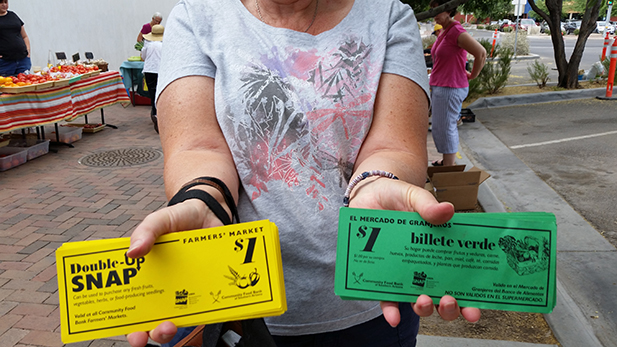 Shoppers on SNAP and WIC can use vouchers at the Community Food Bank’s farmers’ markets to buy fresh produce, and double their benefit up to $20.
Shoppers on SNAP and WIC can use vouchers at the Community Food Bank’s farmers’ markets to buy fresh produce, and double their benefit up to $20. “We have a card reader for SNAP and provide an exchange of market money,” says Jones.
People who receive WIC and SNAP can double their benefits up to $20 by shopping at the Community Food Bank’s farmers’ markets. The Food Bank received a grant to support the program.
“Even people who are above the ridiculously low poverty level still struggle to make ends meet.” – Michael McDonald, CEO, Community Food Bank of Southern Arizona
“Within the City of Tucson alone, it’s 93,600 individuals that are receiving hunger relief services this very month,” says Michael McDonald, CEO of the Community Food Bank of Southern Arizona. That’s 18 percent of Tucsonans. “Even people who are above the ridiculously low poverty level still struggle to make ends meet. And so they are balancing their budget through watering down their food. If, they’re a mom, she’s not eating so they can eat; buying prescription medicines if they’re an elder -- and they go without food.”
He says the Community Food Bank doesn’t expect to solve the problem of hunger, but it’s trying to chip away at the root causes by creating more economic opportunities for low-income people. And that includes small farmers.
“The reality is a lot of us don’t make enough money to pay all the bills,” says Anne Loftfield. She’s selling tomatoes and greens at her table. Her farm is called High Energy Agriculture. It’s in Marana. “I’m on Social Security and Medicare. The farm does not pay any of my living expenses. Bottom line.”
Does selling at this farmer’s market supplement her income?
“It more keeps the farm going,” says Loftfield. “Pays for the seeds and the water, and needs to get a little bit better to pay for our labor.
Farming is a tough business. According to the U.S. Department of Agriculture 69 percent of small farms don’t make a profit. Kara Jones says many of the farmers who sell at the Community Food Bank’s farmers’ markets are low-income.
“Last week we broke a record [in sales],”says Don Breckenfeld of Breckenfeld Family Growers. They made $485. He says it was not a significant supplement to his family’s income. “It pays for the cost of the water, maintenance. This is a hobby.”
Kara Jones hopes that farmers who sell here regularly will profit more over time because they’ll develop regular customers. That’s what happened to Forever Yong Farm, a few tables down. There’s a line six deep waiting to buy their tomatoes, chard, garlic and okra.
“I came all the way from Flagstaff, actually... I’m here for a conference. When I’m in Tucson and the farmers’ market is going on, I always come and buy.”
 John Rueb, owners of Forever Yong Farm. The Community Food Bank is looking for ways to support local farmers so they can prosper, and so Southern Arizonans can have more healthy, organic food.
John Rueb, owners of Forever Yong Farm. The Community Food Bank is looking for ways to support local farmers so they can prosper, and so Southern Arizonans can have more healthy, organic food. “I buy the okra from him,” says a woman waiting in line. “I came all the way from Flagstaff, actually, to buy it. I’m here for a conference. When I’m in Tucson and the farmers’ market is going on, I always come and buy.”
“Burmese okra!” says John Rueb, owner of Forever Yong Farm. “I just love it. Had some last night for dinner! Very good stuff.”
Rueb grows on six acres. The farm is halfway between Amado and Arivaca, on the Papalote Wash. He’s yanking stakes out of the ground so we can get through one of his fences and check out the crops growing in the field.
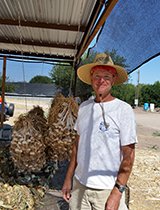 John Rueb grows 15 varieties of garlic at Forever Yong Farm.
John Rueb grows 15 varieties of garlic at Forever Yong Farm.
 Forever Yong Farm
Forever Yong Farm
“Watch out! That fence is electrified so maybe stand over here,” he tells me as I start to lean on it. “We have to fortify it against the javelinas and the deer because they’re very hungry this time of year, and thirsty, and they love cabbage and all of my other vegetables in here. These rows here are butternut squash that will be marketed probably until Christmas or so.”
Farmers don’t just need to know how to grow food. They also need business skills so they can make money. Twenty years ago, Rueb gave up a career in finance. He and his wife and two kids left Chicago to become organic farmers in Southern Arizona. The first year, a plague of grasshoppers wiped out his crops. That’s when he invested in greenhouses.
“I leave the door open until a bird comes in and then the bird tends to eat all the grasshoppers in the greenhouses,” he says as we walk over to see what’s growing in one of his three greenhouses.
“There’s some chard down there. A lot of other farms in the Tucson area -- maybe their season is over for these greens, and so I have kind of a competitive advantage this time of year that I can still produce greens. We want to keep our greenhouses very productive because they were expensive to build and we need a return on our investment.”
“Not a lot of money in farming.” –John Rueb, Owner, Forever Yong Farm
He says Forever Yong is profitable. He also says his wife works in Tucson three days a week as a bookkeeper.
“Her supplemental income is very welcome!” he says with a laugh. “Not a lot of money in farming.”
The big money for growers comes from contracts with large institutions like schools and hospitals. Those orders are usually placed a year in advance so farmers know what to plans and they know they can count on selling that harvest. But those contracts are out of reach for small farmers. Forever Yong would need more infrastructure, like refrigerated storage and refrigerated trucks. And Rueb’s operation is just too small to fill big orders.
But the Community Food Bank has refrigerated trucks, and drivers, and refrigerated storage. Last year, it went into the food brokerage business. It’s called the Farm-to-Institution program. It helps small farmers compete with big, out-of-state growers for local contracts. Kara Jones is in charge. She negotiates with institutions like the Tucson Medical Center and Tucson Unified School District, and then the 20 small farmers who participate in the program combine their crops so they can fill the big orders.
“It’s rainbow chard. It’s just so crispy, so fresh and delicious!” –Berth Dorsey, Director of Nutrition and Food Services, Tucson Medical Center
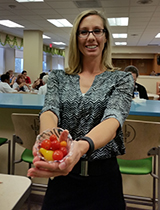 Beth Dorsey, Director of Nutrition and Food Services at Tucson Medical Center. She buys local organic produce for TMC from the Community Food Bank’s Farm-to-Institution program.
Beth Dorsey, Director of Nutrition and Food Services at Tucson Medical Center. She buys local organic produce for TMC from the Community Food Bank’s Farm-to-Institution program.“TMC is buying my chard right now,” says Rueb, “and that’s great because I have lots of chard and I wouldn’t be able to sell it if wasn’t for them putting this deal together.”
“It’s rainbow chard. It’s just so crispy, so fresh and delicious!” says Beth Dorsey, Director of Nutrition and Food Services at TMC. “We usually receive it the day after it’s harvested so the nutrient value is right there.”
She says TMC buys 300 pounds of produce a month from the Farm-to-Institution program because “we want to serve healthier foods to our visitors, our guests and our patients.”
TMC is a nonprofit community hospital, and it serves a lot of the Community Food Bank’s clients. Kara Jones says this is not a coincidence. It’s all part of the Food Bank’s bigger strategy: to make healthy, organic food available to low-income people.
Jones says the Food Bank has another agenda when it comes to the Farm-to-Institution program and farmers’ markets. It wants to prepare Southern Arizona for the uncertainties of climate change. She says: “It’s a pretty big bet to say, ‘Oh, we’ll always be able to get our fresh healthy food from Mexico or California or Florida.’ We need local agriculture in order to ensure that we have food in this region.”
The Community Food Bank is investing in the local food system. It wants to make sure we will all eat well into the future.
This is the final episode of Feeding our Future. Special thanks to Celeste Wesson, Mark McLemore, Peter Michaels, Steve Bayless, Jim Blackwood and MK LeFevour. You can hear all nine stories on the Arizona Spotlight page at AZPM.org.

By submitting your comments, you hereby give AZPM the right to post your comments and potentially use them in any other form of media operated by this institution.